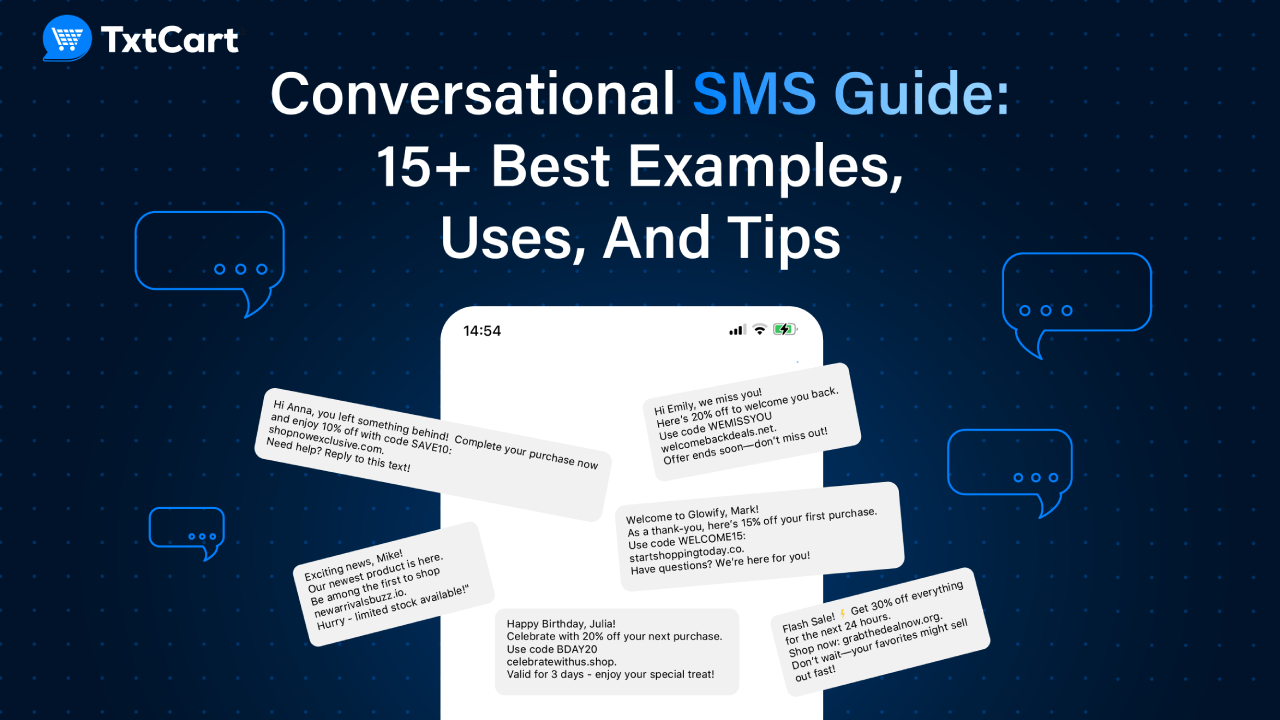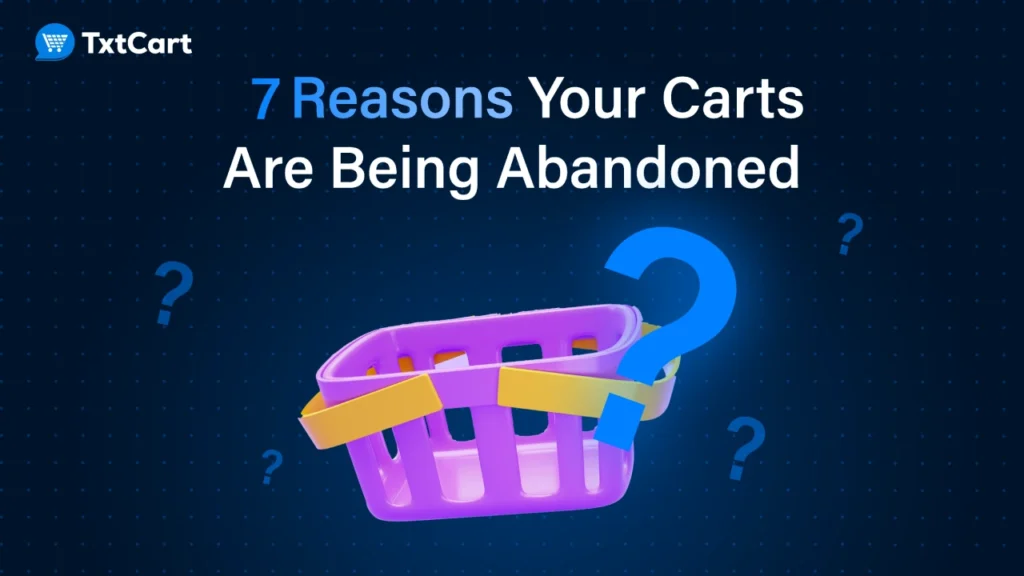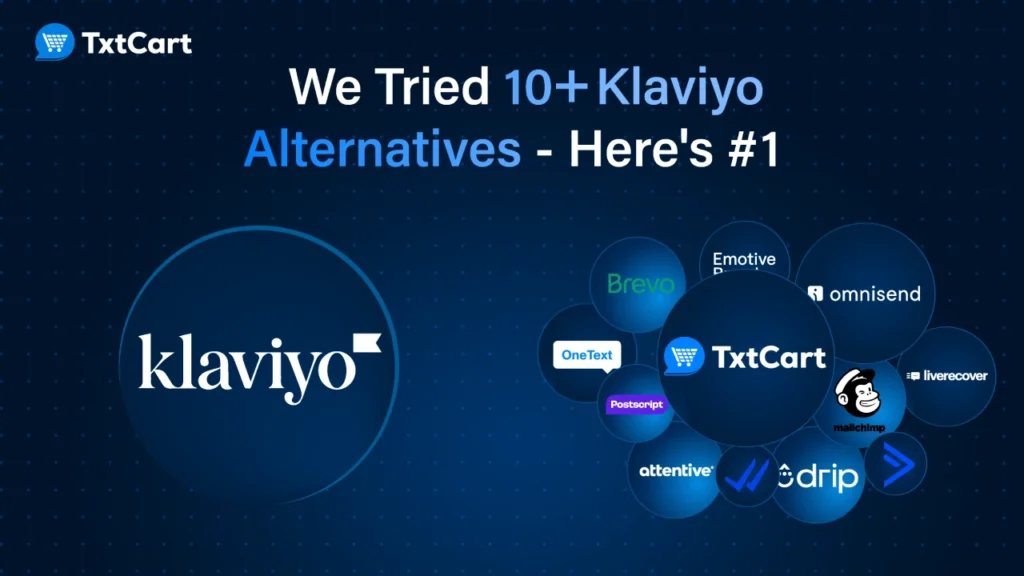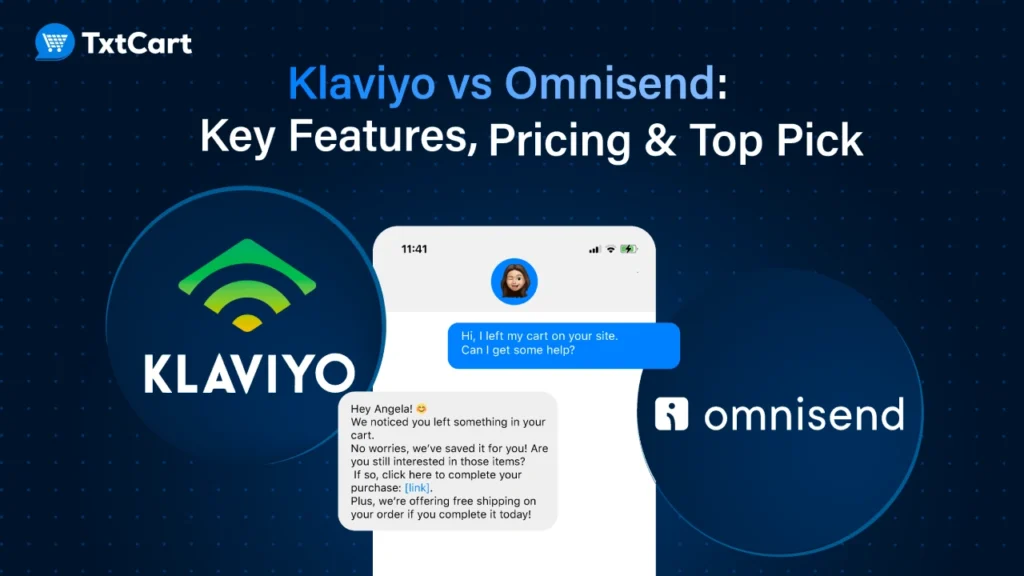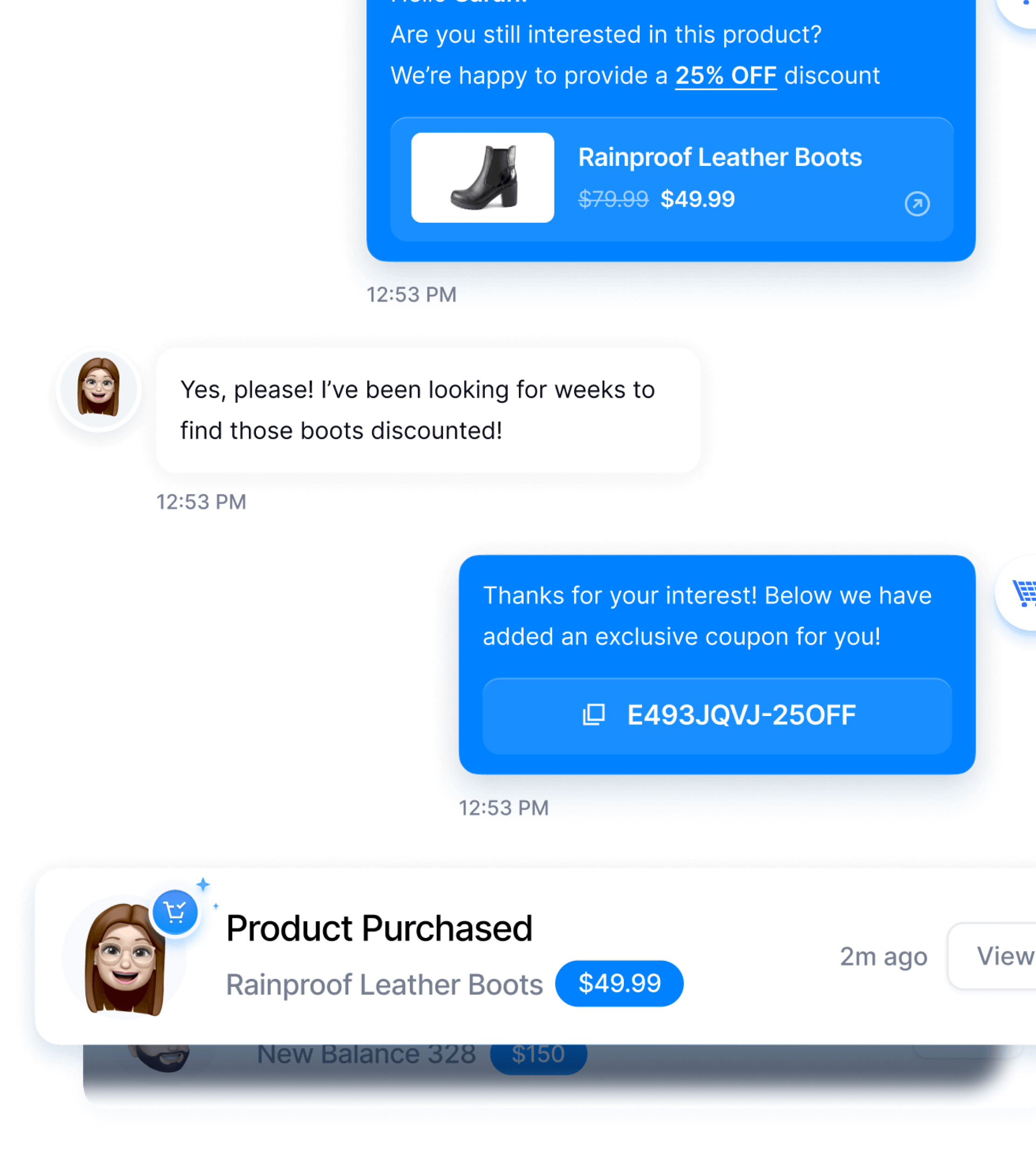Customers are done with one-way messages.
They want to text back, ask questions, and get quick real-time answers (not just another promo code).
The days of one-sided messages are going away, fast.
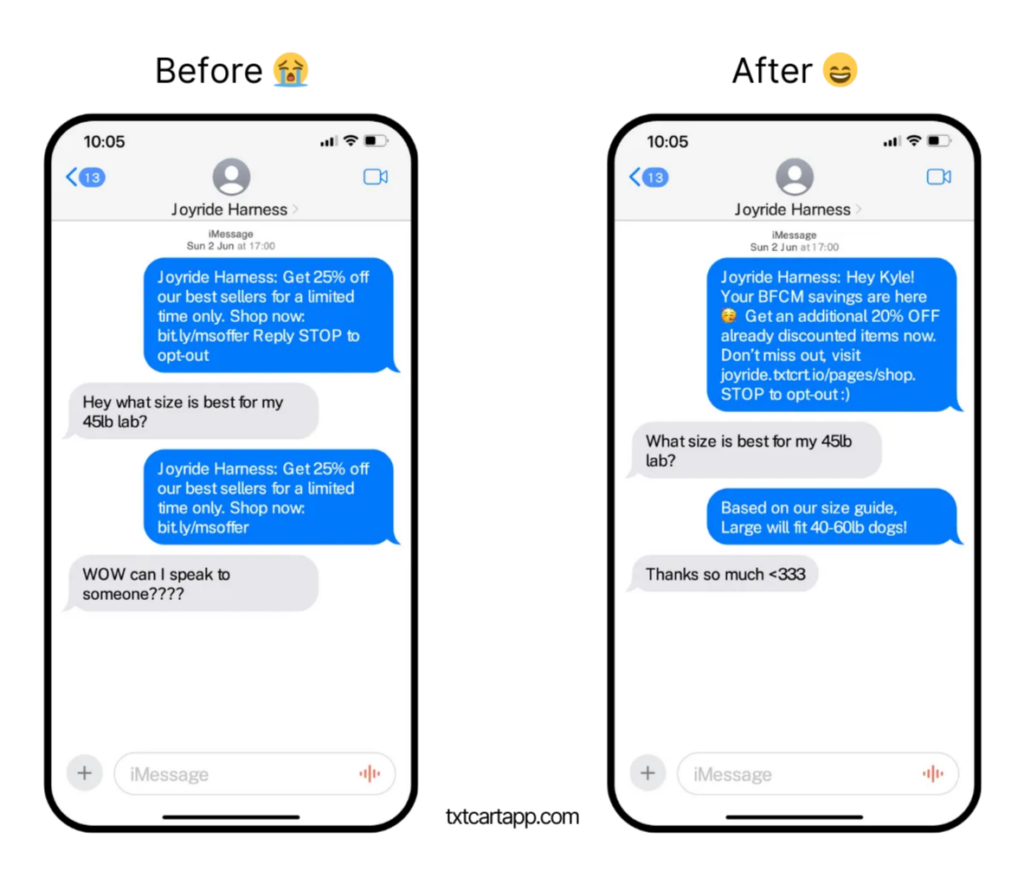
And that’s why conversational SMS is the next big thing. It turns simple texts into two-way conversations, improving customer engagement and trust while also increasing sales.
In fact, if your Shopify store or E-commerce brand isn’t using it yet, this might just be the missing piece in your marketing strategy.
Let’s break down exactly what conversational SMS is, why it matters, and how you can start using it to transform customer engagement.
Want to try conversational SMS for free?
Drive more sales with intelligent AI-driven automations that recover carts, engage customers, and streamline flows — saving you 32x in costs. No contracts or minimums.
- Try free for 14 days
- 10x ROI guaranteed
What is Conversational SMS?
Conversational SMS is two-way text messaging designed to create real-time, personalized interactions with your customers. Unlike traditional SMS marketing, which feels like a broadcast, conversational SMS is interactive. It’s a dialogue, not a monologue.
Instead of sending customers with generic promotions, you’re giving them a chance to reply, ask questions, and get personalized help. This approach feels like a real conversation—even when automation is involved.
Why It Stands Out
- Personalized Engagement: Messages feel human, even if automation is handling the bulk of responses.
- Instant Customer Feedback: Customers can respond, giving you direct insights and valuable data.
- Higher Open and Response Rates: With open rates over 98%, SMS already outperforms email. But conversational messaging takes it a step further by increasing engagement through interaction.
With conversational messaging, you’re reaching your customers AND engaging them. And this kind of engagement translates to higher conversion rates and better customer experiences.
Conversational SMS vs. Traditional SMS vs. Two-Way SMS
Now, not all forms of SMS marketing are going to give you similar results. Here’s a quick breakdown of how conversational SMS, traditional SMS, and two-way SMS differ.
| Feature | Traditional SMS | Two-Way SMS | Conversational SMS |
|---|---|---|---|
| Message Type | One-way, broadcast | Two-way, basic replies | Two-way, interactive dialogue |
| Personalization | Minimal | Limited | High, tailored responses |
| Automation | Yes, basic templates | Limited automation | Advanced AI and Natural Language |
| Customer Engagement | Low | Moderate | High, real-time interaction |
| Uses | Promotions, alerts | Customer feedback | Customer support, sales |
1. Traditional SMS
Traditional SMS is a one-way communication channel. You send out a message, and that’s it. There’s no expectation for a reply. It’s great for sending promotions, alerts, or reminders. Think of it like a loudspeaker announcement: you’re pushing a message out to everyone on your list.
Example:
- “Don’t miss our Black Friday sale! 20% off sitewide.”
It’s efficient but lacks personalization and interaction. Customers can’t reply or ask questions, which limits engagement.
Read Next: Best Black Friday SMS Templates And Examples
2. Two-Way SMS
Two-way SMS allows for basic interaction. Customers can reply to your message, and you can respond back, but it’s often limited and not dynamic. It’s mostly used for things like customer suggestions or support inquiries.
Example:
- Brand: “Rate your shopping experience from 1-5.”
- Customer: “4”
- Brand: “Thanks for your feedback!”
It’s better than one-way messages, but without the context and personalization of conversational messaging, it can still feel robotic.
3. Conversational SMS
Conversational SMS marketing takes two-way messaging to the next level. It uses AI and natural language processing to create a dialogue that feels human.
It’s designed for real-time engagement, allowing customers to ask questions, get instant responses, and even complete purchases—all through a simple text message.
Example:
- Brand: “Hi [Customer’s Name], We noticed you left a pair of shoes in your cart. Need any help deciding?”
- Customer: “Yes, what’s the return policy?”
- Brand: “You can return them for free within 30 days! Want us to hold your size for another 24 hours?”
The goal here is to replicate a real conversation. It’s about responding and anticipating needs, offering a better customer experience.
How much revenue could you add from SMS marketing? 🤔
Use our revenue calculator to find how many more sales you could be driving from your SMS marketing campaigns with TxtCart.
Does Conversational SMS Really Matter?
Now here’s the thing:
Customers don’t open emails like they used to. But they always check their phones. That’s why conversational SMS has become SO important for eCommerce brands. Here are some of the top benefits of conversational sms marketing:
1. 90%+ Open Rates (Far Better Than Email)
Most people read texts within 3 minutes of receiving them. Compare that to email, where open rates hover around 20%. With conversational messaging, you’re exploring an effective marketing channel where your message actually gets seen. No more emails lost in spam folders or promotional tabs.
Pro Tip: Use conversational messaging for time-sensitive offers. Send a quick text about a flash sale or limited-time offer—customers won’t miss it. Additionally, test different versions of these time-sensitive offers through SMS A/B Testing. This way, you can identify the type of offer that drives the most urgency and response from your audience.
2. More Direct And Personal
SMS feels personal because it’s right in your customer’s pocket. It’s not just another random email. It’s a direct line of communication. This actually builds more trust.
When customers can reply and get real answers, it feels like a one-on-one conversation—even if it’s automated.
Example: Instead of sending “20% off sale now,” try texting:
“Hi [Customer Name], we saved 20% off just for you! Have any questions? Text us back.”
3. Hard To Ignore
You know it. We all do it. We check every notification on our phones. It’s almost impossible to ignore an incoming text. This makes SMS an incredibly powerful tool, especially for abandoned cart recovery or urgent updates.
Read Next: What Is SMS Remarketing? Top Strategies And Best Practices
4. Highly Profitable (Organi’s Case Study)
Conversational messaging isn’t just about engagement, it’s also a proven moneymaker. Let’s look at Organi. By switching to TxtCart, they drove $1,248,723 in SMS-attributed revenue with an ROI of 16.9X. The key? Engaging customers with personalized texts and answering their questions instantly.
Organi Grow Hair, a vegan and organic haircare brand, used TxtCart’s 2-way SMS to recover $25K monthly, drive 42% reply rates, and deliver 9,500+ personalized campaign orders.
$1,248,723
Revenue Attributed to SMS
26,241+
Orders Attributed to SMS
16.9x
SMS Attributed ROI

“TxtCart has really built something special and we’ve been a fan for over 3 years. The organic conversations pair so well with our organic products, providing additional revenue and customer satisfaction.”
Founder, Organi Hair
And here’s another example. Chaser, a fast-fashion brand based in LA, leaned into conversational messaging with TxtCart and saw results almost immediately. They generated over $207,341 in SMS-attributed revenue in just 9 months. Abandoned carts that were once lost sales became opportunities for real conversations, boosting their recovery rate to 54%.
Chaser, an LA-based fashion brand, leveraged TxtCart’s 2-way SMS to generate $207,341 in revenue, with over 10,983 customer conversations and a 42.78% reply rate, resulting in 1,100+ orders generated.
$207,341
SMS Attributed Revenue
10.8x
SMS Attributed ROI
1,100+
Orders Generated

“Kyle and Hunter have been absolutely outstanding to work with and the platform has exceeded expectations. The ROI has been amazing and I’m excited for the future!”
CEO, Chaser Brand
What Worked for Chaser:
- Using TxtCart’s AI-driven replies to respond quickly and contextually.
- Tailoring offers based on customer preferences, driving higher engagement.
16 Best Uses Of Conversational SMS In Marketing With Examples
Now, let’s look at some of the top ways to use conversational SMS in marketing with examples for each.
1. Abandoned Cart Recovery
Abandoned carts are a huge problem. Customers add items to their carts but never check out. Conversational SMS fixes this by reaching out in real time, offering a nudge, or answering any concerns.
Example:
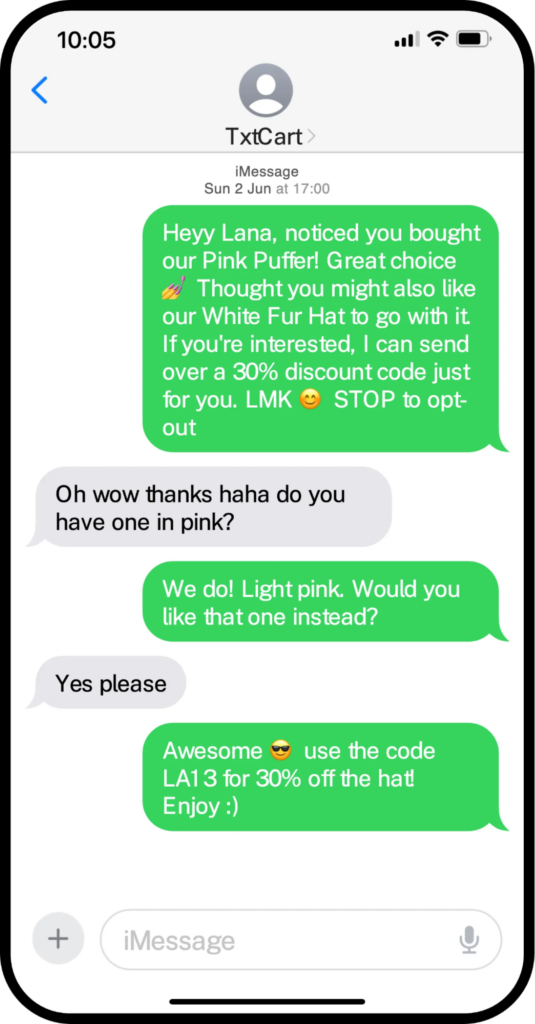
Why It Works:
- Personalized reminder that feels human.
- Real-time responses to questions about shipping, returns, or discounts.
- TxtCart users see recovery rates as high as 33%.
2. Customer Surveys And Feedback
Want to know how your customers feel about a recent purchase? Ask them directly. SMS surveys get quicker responses than email and provide direct insights.
Example:
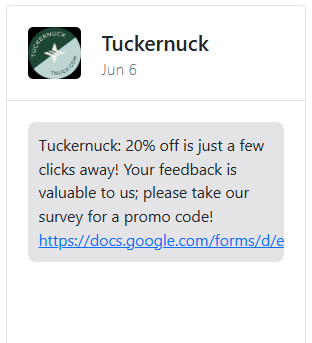
Why It Works:
- Starts off with a clear benefit.
- Simple, clear, and short with a clear call to action.
Pro Tip: Keep it short and simple. Customers are more likely to respond when it’s easy. TxtCart’s AI can handle follow-up questions based on the initial response, diving deeper into what customers liked or didn’t.
3. Appointment Reminders
Appointment no-shows cost businesses time and money. A quick SMS reminder reduces missed appointments and keeps customers on track.
Example:
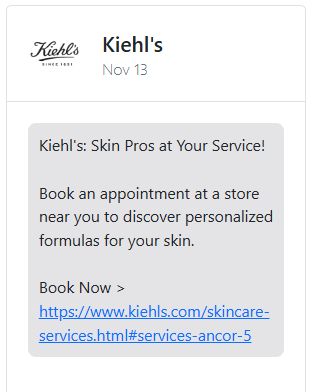
Why It Works:
- Simple confirmation or rescheduling options.
- Reduces no-show rates with a clear call to action.
4. Content Sharing
Got a new blog post, product guide, or video? Share it via SMS. It’s a great way to keep your audience engaged without relying solely on email.
Example:
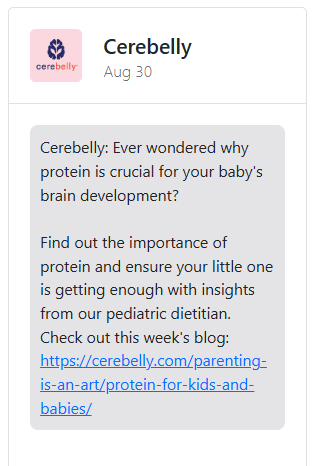
Why It Works:
- Highly relevant resource for the target audience.
- Educates the audience with valuable and helpful tips.
Pro Tip: Use conversational messaging for exclusive content. Customers appreciate getting first access, and it builds brand loyalty.
5. Direct Texting For VIPs
Your most loyal customers deserve special treatment. Offer them exclusive deals or early access via direct SMS.
Example:
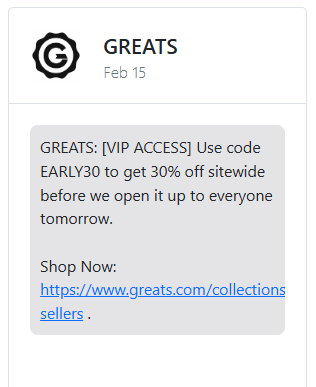
Why It Works:
- Creates urgency with a clear time limit.
- Makes customers feel special with a special discount offer.
- Short and simple with a clear call to action.
6. Lead Generation
Use SMS to capture leads quickly. Whether it’s through a giveaway, quiz, or exclusive offer, SMS lead generation works because it’s direct.
Example:

Why It Works:
- High opt-in rates because of the high-value offer.
- Creates urgency because of a clear time limit.
- Immediate engagement and easy follow-up.
7. Loyalty Programs
Reward your repeat customers with exclusive offers. Use SMS to keep them updated about their points, rewards, and special perks.
Example:
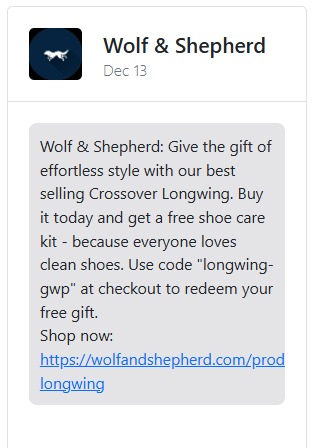
Why It Works:
- Begins with a clear valuable offer.
- Conversational, and relatable messaging that feels more personal rather than promotional.
- Clear call to action at the end.
Pro Tip: Connect your loyalty program with SMS to keep it top-of-mind for customers.
8. Welcome Messages For New Subscribers
First impressions matter. A friendly welcome message sets the tone for your relationship. It’s not just a “hello”—it’s an opportunity to introduce your brand, offer a discount, and encourage first-time purchases.
Example:
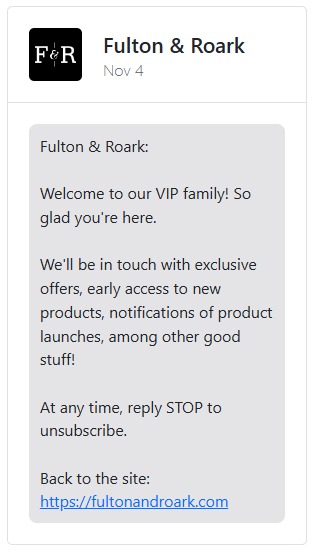
Why It Works:
- High engagement rates.
- Immediate connection with the customer.
- Opportunity to answer any questions they might have.
9. Birthday And Special Occasion Offers
Customers love feeling special on their big day. Sending a personalized birthday message with a discount is a simple way to delight them and drive sales.
Example:
“Happy Birthday, [Customer Name]! 🥳 To celebrate, enjoy 20% off your next order. Use code BDAY20: [Link]. Hope it’s your best year yet!”
Why It Works:
- Creates a personal connection.
- Increases customer loyalty.
- High conversion rates since customers often shop for themselves during special occasions.
Pro Tip: With TxtCart’s Campaign Planner, you also get access to a wide range of ready-to-use templates for all popular occasions. Use these templates to craft effective SMS marketing campaigns.
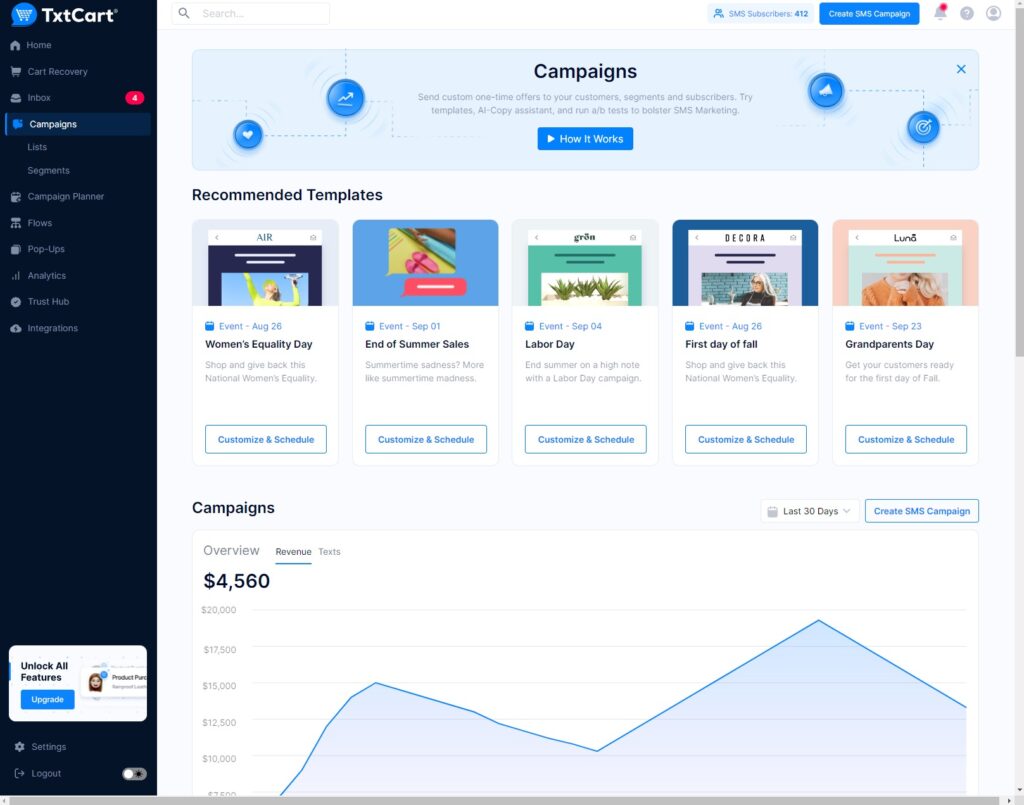
10. Customer Support Updates
Keeping customers informed about their order status and answering their common questions builds trust. Real-time SMS updates paired with conversational support make the experience seamless.
Example:
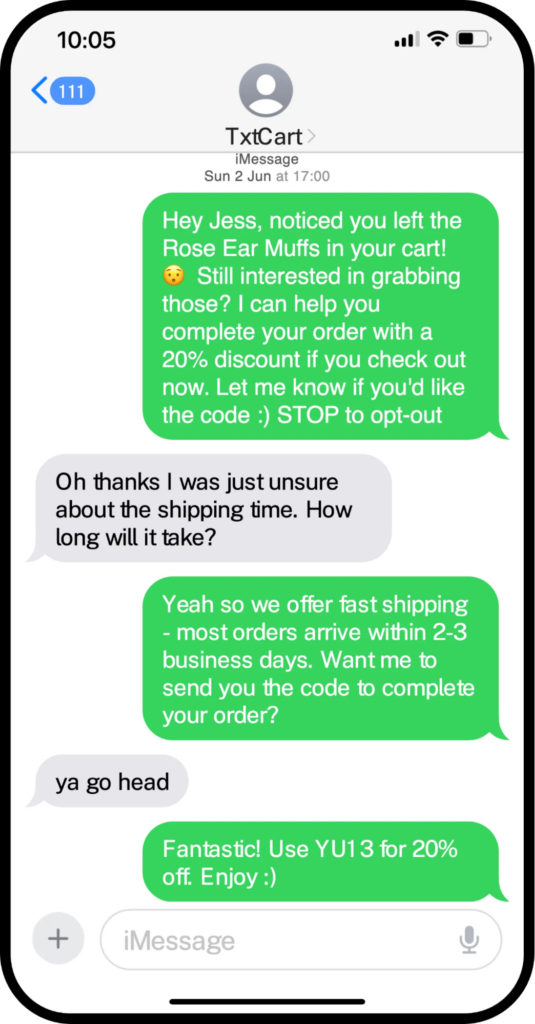
Why It Works:
- Reduces customer support inquiries by proactively providing updates.
- Creates a sense of security for the customer.
- Increases post-purchase satisfaction and repeat sales.
TxtCart’s Advantage:
TxtCart can handle questions like “When will my order arrive?” automatically, freeing up your team to handle more complex issues.
12. Re-Engagement With Dormant Customers
It’s easier (and cheaper) to win back a past customer than to acquire a new one. Use SMS to remind inactive customers what they’re missing, and offer an incentive to bring them back.
Example:
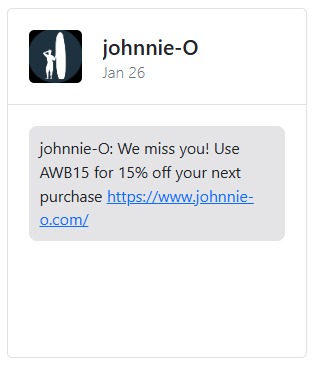
Why It Works:
- Use of personalized conversational messaging to develop connection with dormant connection and make them feel valued.
- Short and simple messaging that doesn’t overwhelm inactive customers.
- Provides immediate value with a clear call to action.
Pro Tip: Segment your audience based on inactivity length (e.g., 30 days, 60 days) and customize your message accordingly. With TxtCart’s segmentation, you can easily segment and personalize your conversational SMS marketing campaigns.
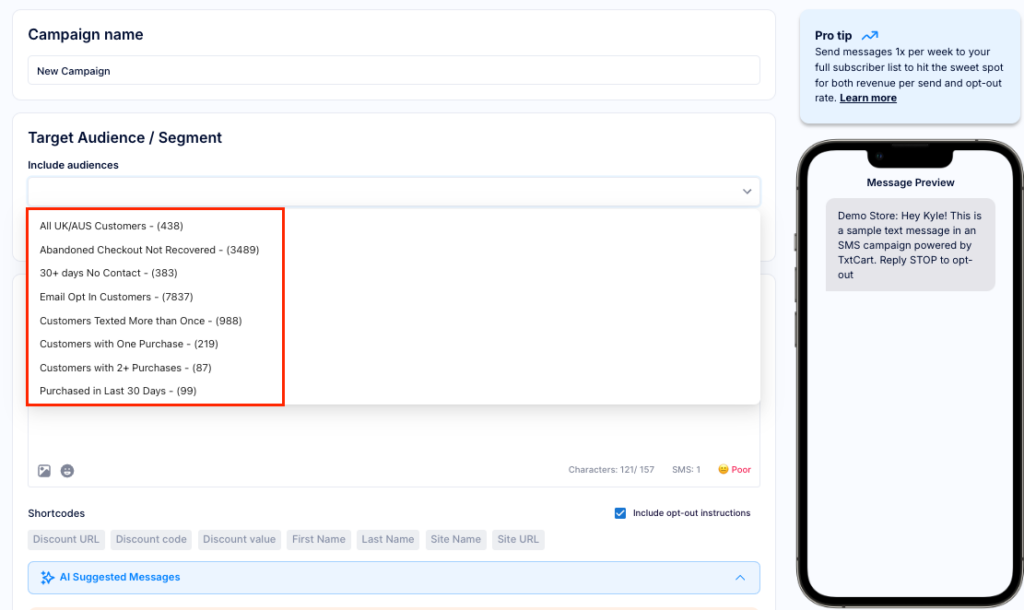
13. Product Launch Announcements
Product launches are your chance to create buzz and excitement. SMS gets the message across fast, directly to your most engaged customers.
Example:
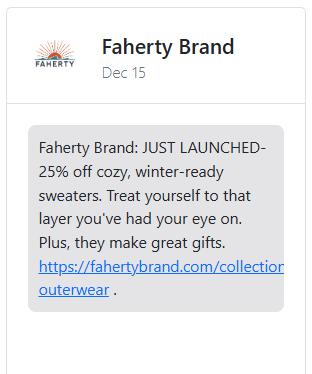
Why It Works:
- Creates urgency and exclusivity.
- Immediate traffic boost to your site.
- Customers feel valued getting the first look.
14. Drip Campaigns For New Customers
Guide new customers through a journey with a series of timed messages. Start with a welcome, follow up with product tips, and finish with a special offer.
Example Sequence:
- Day 1: “Welcome! Here’s 10% off your first order: [Link].”
- Day 3: “Did you know we offer free returns? Shop worry-free: [Link].”
- Day 7: “Haven’t made your first purchase yet? Here’s a reminder with 15% off: [Link].”
Use TxtCart to automate these messages based on customer behavior, so you’re always sending the right message at the right time.
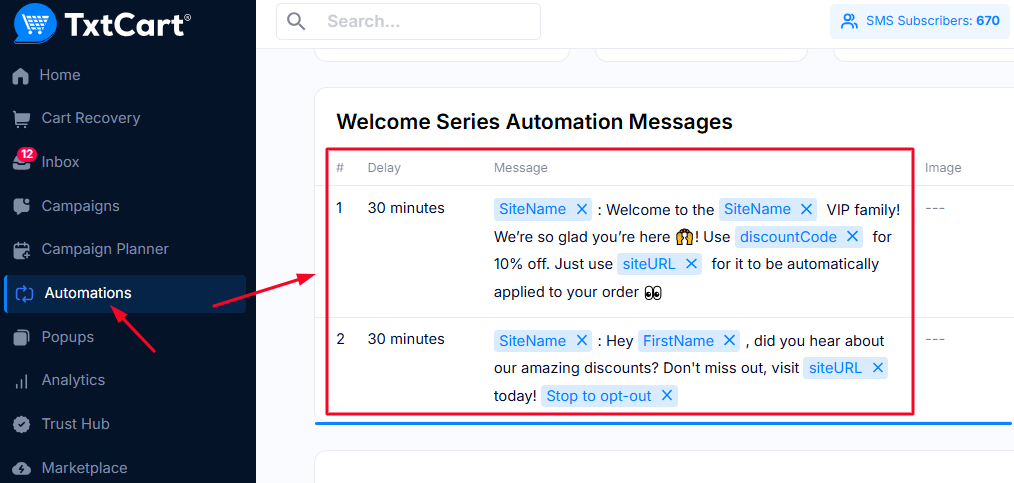
15. Sales Promotion Messages
When you need a quick sales boost, SMS is the way to go. It’s immediate, direct, and grabs attention fast.
Example:
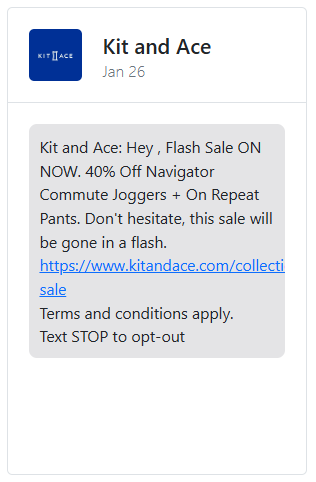
Why It Works:
- Creates urgency.
- Clearly communicates the value with a strong call to action.
- Short and simple conversational message.
16. Referral Text Messages
Word-of-mouth is powerful, and referrals are a great way to tap into your existing customer base to find new leads.
Example:
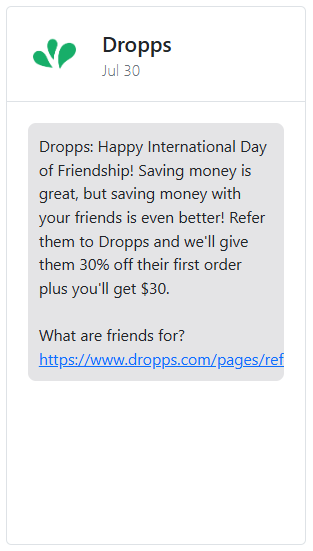
Why It Works:
- Engages satisfied customers.
- Low-cost lead generation.
- Boosts brand awareness organically.
Tips And Strategies For Effective Conversational SMS Marketing
Now, conversational SMS marketing is easy. But doing it well? That’s the challenge. Here’s how to make sure your SMS campaigns stand out, feel personal, and actually drive results.
1. Respect The Conversation Format
SMS is personal. It’s right there in your customer’s pocket, mixed in with texts from their friends and family. So don’t be spammy. Avoid overly promotional messages that feel like a broadcast. Instead, focus on providing value and being genuinely helpful.
Example:
Instead of: “Flash Sale! 20% off everything. Buy now!”
Try: “Hi [Customer Name], noticed you were eyeing that hoodie. It’s 20% off today. Have any questions before you buy?”
Why It Works:
- Feels like a real conversation, not an ad.
- Builds trust by being responsive rather than pushy.
- Customers are more likely to reply, which boosts engagement.
Pro Tip: Always include a clear opt-out option like “Reply STOP to unsubscribe.” This shows respect for your customer’s space and builds trust.
2. Timing And Frequency: Don’t Overdo It
Less is more with SMS. Your customers are bombarded with notifications all day long. Sending too many texts will get you muted or unsubscribed faster than you can say “flash sale.” Aim for 1-2 messages per week, max. This keeps your brand top-of-mind without being overwhelming.
When To Send:
- Promotions: Send during peak shopping hours (11 AM – 2 PM).
- Order Updates: Right after a purchase or when there’s a shipping update.
- Abandoned Carts: Within 1-2 hours after the cart is abandoned. Any longer, and the interest may fade.
3. Crafting Engaging Messages: Be Friendly and Fun
Your SMS needs to sound like a real person wrote it. Keep it casual, use a friendly tone, and don’t be afraid to sprinkle in emojis. They add personality and make your message pop in a sea of plain text.
Example:
“Hey [Customer Name], your order is on its way! Can’t wait for you to get it. Need any help in the meantime? Just reply here.”
Why It Works:
- Short, sweet, and to the point.
- Feels more like a text from a friend.
- The emoji grabs attention and adds a friendly vibe.
Pro Tip: Keep your messages under 160 characters. Longer texts get split into multiple messages, which can be annoying for customers and might increase your costs.
4. Gathering And Using Customer Feedback
Your customers are your best source of information. Don’t just guess what they want—ask them. SMS is a great way to collect quick feedback. It’s direct and gets faster responses than email surveys.
Example:
“Hi [Customer Name], how did you like your recent purchase from [Brand Name]? Reply with a number from 1-5 (1 = needs improvement, 5 = loved it!).”
Pro Tip: Follow up on lower ratings (1-3) with a personalized message or a small offer to make it right. This turns a negative experience into a chance to build loyalty.
Using Feedback:
Analyze feedback data to refine your SMS strategy. For example:
- If customers love free shipping, highlight it more in your promos.
- If they mention issues with sizing, offer help with a size guide link.
5. Create The Customer Journey For Strategic SMS Engagement
Not every customer interaction needs an SMS. Analyze customer journey to find out where conversational text messaging makes the most impact. The key is to engage at strategic moments, not randomly.
Here’s How It Can Look:
- Pre-Purchase Inquiry: When a customer has questions about a product before buying, use conversational SMS to answer and guide them to checkout.
- Abandoned Cart: A gentle nudge to complete the purchase, ideally with a small incentive or offer of help.
- Post-Purchase Support: Order updates, tracking info, and a follow-up message asking for feedback.
- Loyalty Program Engagement: Reward VIP customers with exclusive offers and early access to sales.
- Re-Engagement: Remind inactive customers of what they’re missing out on, like a restocked product or a special sale.
This kind of structured approach helps you understand where conversational SMS fits into your customer’s lifecycle. It maximizes engagement without feeling intrusive.
With TxtCart’s Analytics, you can easily track key metrics like cart recovery, total SMS sent, and total revenue. Use this data to optimize your SMS strategy over time.

Getting Started With Conversational SMS
Ready to dive in? Let’s go through the key steps you need to set up a successful conversational SMS strategy. This isn’t just about sending messages—it’s about creating a system that scales, engages, and converts.
1. Building Your SMS List: Opt-In Strategies That Work
For growing your SMS list you want quantity as well as quality. You want engaged customers who actually want to hear from you. The best way to do this? Offer value right from the start.
Top Strategies:
- Pop-Ups on Your Site: Use a pop-up to capture both email and phone numbers. Offer a discount or free shipping as an incentive.
- Checkout Opt-In: Include a checkbox at checkout asking customers if they’d like to receive updates via text.
- Social Media Promotions: Run a giveaway or offer an exclusive deal for customers who opt into your SMS list via Instagram or Facebook.
Best Practices:
- Always get explicit consent. Use clear language like, “Sign up for text updates and get 10% off your first order.”
- Include an easy opt-out option in every message (e.g., “Reply STOP to unsubscribe”). This builds trust and keeps your list healthy.
Read Next: SMS Marketing Strategies Using Consumer Psychology
2. Choosing The Right Tools And Technology
Not all SMS platforms are created equal. You need tools that support two-way conversations, automation, and real-time responses. Here’s a quick rundown of what to look for:
- TxtCart: Designed for eCommerce, TxtCart offers conversational AI, abandoned cart recovery, and seamless Shopify integration. It’s perfect if you want a complete solution for customer engagement and sales.
- Klaviyo: Great for brands already using email marketing. Klaviyo integrates SMS with email flows, making it easy to create a cohesive experience.
- Gorgias: Best for customer support. Gorgias centralizes messages from email, SMS, and social media, so your support team has everything in one place.
- Zendesk: Ideal for larger brands looking for advanced customer service features. Integrates well with multiple communication channels, including SMS.
Start with TxtCart, especially for its focus on eCommerce. The AI-powered features make it easy to handle common questions and boost conversions without needing a huge support team.
3. Creating Automated Responses: Scale Without Losing the Personal Touch
Automation is really important for SMS marketing. It lets you respond instantly without having to manually type out each message. But the key is to keep it personal. Your customers shouldn’t feel like they’re talking to a robot.
Tips To Implement:
- Set up Quick Replies for common questions like shipping info, return policies, or product availability. This covers 70-80% of inquiries.
- Use Personalization Tokens (e.g., customer name, order details) to make automated messages feel unique.
- Don’t over-automate. Leave room for real human interaction, especially when handling complex questions or customer complaints.
Example:
Automated response: “Hi [Customer Name], your order [Order number] has shipped! 🎉 Track it here: [Link]. Have any other questions? Just reply, and we’ll get back to you quickly.”
TxtCart’s AI assistant can handle automated responses seamlessly, transitioning to live agents when needed for more complex conversations.
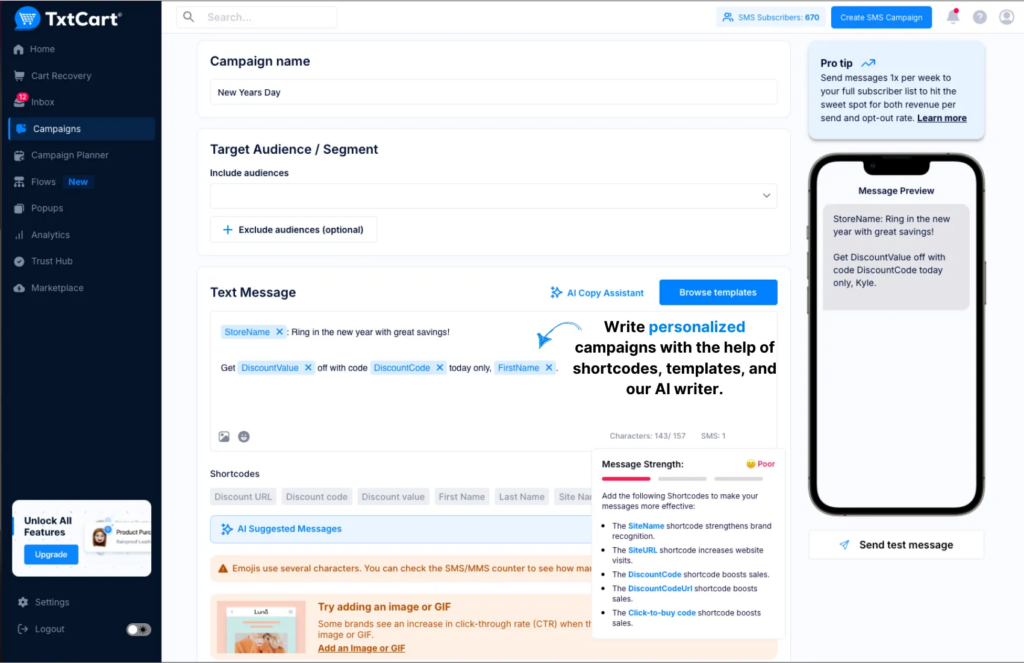
4. Integrating Human Support: When AI Isn’t Enough
Automation handles the basics, but there are times when only a real person can solve the issue. Knowing when to switch from AI to a live agent is crucial for maintaining a great customer experience.
Best Practices:
- Use AI for routine tasks like order updates, FAQs, and simple product questions.
- Transition to a human agent for high-value customers, complaints, or complicated issues.
- Clearly communicate when a message is being handed off to a live agent. This sets the right expectations and avoids frustration.
Example Message:
“Our support team is taking over from here to help you out. Hang tight, and we’ll get back to you shortly!”
Turn Conversation Into Sales With TxtCart
Getting started with conversational SMS doesn’t have to be overwhelming. Start small: focus on customer service, then expand to promotional campaigns as you learn what works. Remember, it’s all about creating a dialogue, not just sending messages.
Key Takeaways:
- Build your SMS list with clear opt-in strategies and incentives.
- Choose tools like TxtCart that support real-time, two-way conversations.
- Automate common responses but keep the human touch for complex issues.
- Create your customer journey and engage at key moments for maximum impact.
TxtCart is built for eCommerce brands that want to connect with their customers on a deeper level. With features like AI-powered quick replies, abandoned cart recovery, and personalized messaging, you get everything you need to boost engagement and drive sales—all from one platform.
Ready to see the results of real conversations? Book a demo or try TxtCart’s 14-day risk-free trial now!
Joyride, an LA-based dog harness brand, leveraged TxtCart’s 2-way SMS to generate $1,841,617 in revenue, with 23,616 sales generated and over 2.8M customer conversations, driving massive growth in their eCommerce operations.
$1,841,617
SMS Attributed Revenue
12.4x
SMS Attributed ROI
23,616
Sales Generated
“Kyle and the team at TxtCart have been instrumental in our growth. They’ve worked closely with us to create custom solutions and the results have been phenomenal. TxtCart has helped us scale significantly and provided support at every turn.“
Founder, Joyride
Read Next:
